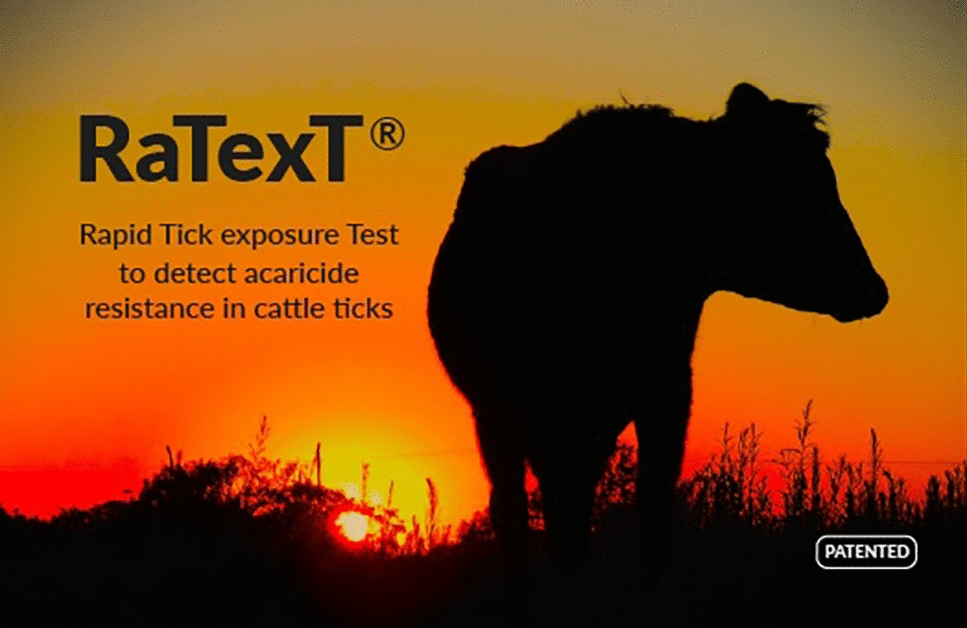Jongejan F, Uilenberg G. The global importance of ticks. Parasitology. 2004;129:S3-14.
PubMed
Google Scholar
Strydom T, Lavan RP, Torres S, Heaney K. The economic impact of parasitism from nematodes, trematodes and ticks on beef cattle production. Animals. 2023;13:1599.
PubMed
PubMed Central
Google Scholar
Rodriguez-Vivas RI, Jonsson NN, Bhushan C. Strategies for the control of Rhipicephalus microplus ticks in a world of conventional acaricide and macrocyclic lactone resistance. Parasitol Res. 2018;117:3–29.
PubMed
Google Scholar
George JE, Pound JM, Davey RB. Chemical control of ticks on cattle and the resistance of these parasites to acaricides. Parasitology. 2004. https://doi.org/10.1017/S0031182003004682.
PubMed
Google Scholar
Abbas RZ, Zaman MA, Colwell DD, Gilleard J, Iqbal Z. Acaricide resistance in cattle ticks and approaches to its management: the state of play. Vet Parasitol. 2014;203:6–20.
PubMed
Google Scholar
Dzemo WD, Thekisoe O, Vudriko P. Development of acaricide resistance in tick populations of cattle: a systematic review and meta-analysis. Heliyon. 2022;8:e08718.
PubMed
PubMed Central
Google Scholar
Obaid MK, Islam N, Alouffi A, Khan AZ, da Silva Vaz I, Tanaka T, et al. Acaricides resistance in ticks: selection, diagnosis, mechanisms, and mitigation. Front Cell Infect Microbiol. 2022;12:941831.
PubMed
PubMed Central
Google Scholar
Vudriko P, Okwee-Acai J, Tayebwa DS, Byaruhanga J, Kakooza S, Wampande E, et al. Emergence of multi-acaricide resistant Rhipicephalus ticks and its implication on chemical tick control in Uganda. Parasit Vectors. 2016;9:4.
PubMed
PubMed Central
Google Scholar
Bishop RP, Githaka NW, Bazarusanga T, Bhushan C, Biguezoton A, Vudriko P, et al. Control of ticks and tick-borne diseases in Africa through improved diagnosis and utilization of data on acaricide resistance. Parasit Vectors. 2023;16:224.
PubMed
PubMed Central
Google Scholar
Githaka NW, Kanduma EG, Wieland B, Darghouth MA, Bishop RP. Acaricide resistance in livestock ticks infesting cattle in Africa: current status and potential mitigation strategies. Curr Res Parasitol Vector-Borne Dis. 2022;2:100090.
PubMed
PubMed Central
Google Scholar
de Sousa ABB, Bianchi D, Santos EM, Dias SR, Peleja PL, Santos RR, et al. First description of acaricide resistance in populations of Rhipicephalus microplus tick from the Lower Amazon, Brazil. Animals. 2022;12:2931.
PubMed
PubMed Central
Google Scholar
Klafke GM, Golo PS, Monteiro CMO, Costa-Júnior LM, Reck J. Brazil’s battle against Rhipicephalus (Boophilus) microplus ticks: current strategies and future directions. Rev Bras Parasitol Veterinária Braz J Vet Parasitol. 2024;33:e001423.
Google Scholar
Ghosh S, Nagar G. Problem of ticks and tick-borne diseases in India with special emphasis on progress in tick control research: a review. J Vector Borne Dis. 2014;51:259–70.
PubMed
Google Scholar
Kumar R, Sharma AK, Ghosh S. Menace of acaricide resistance in cattle tick, Rhipicephalus microplus in India: Status and possible mitigation strategies. Vet Parasitol. 2020;278:108993.
PubMed
Google Scholar
Kotze A, Hunt P. The current status and outlook for insecticide, acaricide and anthelmintic resistances across the Australian ruminant livestock industries: assessing the threat these resistances pose to the livestock sector. Aust Vet J. 2023;101:321–33.
PubMed
Google Scholar
Tønnesen MH, Penzhorn BL, Bryson NR, Stoltsz WH, Masibigiri T. Displacement of Boophilus decoloratus by Boophilus microplus in the Soutpansberg region, Limpopo Province. South Africa Exp Appl Acarol. 2004;32:199–208.
PubMed
Google Scholar
Silatsa BA, Kuiate J-R, Njiokou F, Simo G, Feussom J-MK, Tunrayo A, et al. A countrywide molecular survey leads to a seminal identification of the invasive cattle tick Rhipicephalus (Boophilus) microplus in Cameroon, a decade after it was reported in Cote d’Ivoire. Ticks and Tick-borne Diseases. 2019;10:585–93.
PubMed
PubMed Central
Google Scholar
Madder M, Thys E, Achi L, Touré A, De Deken R. Rhipicephalus (Boophilus) microplus: a most successful invasive tick species in West-Africa. Exp Appl Acarol. 2011;53:139–45.
PubMed
Google Scholar
Adinci KJ, Akpo Y, Sessou P, Yessinou RE, Adehan SB, Youssao AKI, et al. Influence of transhumance on the spread of Rhipicephalus microplus (Canestrini, 1888) in Benin. J Adv Vet Anim Res. 2018. https://doi.org/10.5455/javar.2018.e272.
Google Scholar
Adakal H, Biguezoton A, Zoungrana S, Courtin F, de Clercq EM, Madder M. Alarming spread of the Asian cattle tick Rhipicephalus microplus in West Africa-another three countries are affected: Burkina Faso, Mali and Togo. Exp Appl Acarol. 2013;61:383–6.
PubMed
Google Scholar
Addo SO, Bentil RE, Baako BOA, Addae CA, Larbi JA, Baidoo PK, et al. First record of Rhipicephalus (Boophilus) microplus in Ghana, a potential risk to livestock production. Exp Appl Acarol. 2023;89:475–83.
PubMed
Google Scholar
Kamani J, Apanaskevich DA, Gutiérrez R, Nachum-Biala Y, Baneth G, Harrus S. Morphological and molecular identification of Rhipicephalus (Boophilus) microplus in Nigeria, West Africa: a threat to livestock health. Exp Appl Acarol. 2017;73:283–96.
PubMed
Google Scholar
Nagagi YP, Kimaro EG, Temba V. Practical application and the possible emergence of tick resistance to commonly usedacaricides in various districts of Tanzania. Livest Res Rural Dev. 2020;32:8.
Google Scholar
Kumar R, Klafke GM, Miller RJ. Voltage-gated sodium channel gene mutations and pyrethroid resistance in Rhipicephalus microplus. Ticks Tick-Borne Dis. 2020;11:101404.
PubMed
Google Scholar
Chen AC, He H, Davey RB. Mutations in a putative octopamine receptor gene in amitraz-resistant cattle ticks. Vet Parasitol. 2007;148:379–83.
PubMed
Google Scholar
Corley SW, Jonsson NN, Piper EK, Cutullé C, Stear MJ, Seddon JM. Mutation in the RmßAOR gene is associated with amitraz resistance in the cattle tick Rhipicephalus microplus. Proc Natl Acad Sci U S A. 2013;110:16772–7.
PubMed
PubMed Central
Google Scholar
FAO. Recommended methods for the detection and measurement of resistance of agricultural pests to pesticides. Tentative method for larvae of cattle ticks, Boophilus spp. FAO method no 7. Plant Prot Bull. 1971;19:15–8.
Google Scholar
Stone BF, Haydock KP. A method for measuring the acaricide-susceptibility of the cattle tick Boophilus microplus (Can.). Bull Entomol Res. 1962;53:563–78.
Google Scholar
FAO. Guidelines: resistance management and integrated parasite control in ruminants. 2004.
FAO. Guidelines for sustainable tick control and acaricide resistance management in livestock. Animal Product Health Guidelines. 2025. https://doi.org/10.4060/cd0000en.
Google Scholar
Sabatini GA, Kemp DH, Hughes S, Nari A, Hansen J. Tests to determine LC50 and discriminating doses for macrocyclic lactones against the cattle tick, Boophilus microplus. Vet Parasitol. 2001;95:53–62.
PubMed
Google Scholar
Shaw RD. Culture of an organophosphorus-resistant strain of Boophilus microplus (Can.) and an assessment of its resistance spectrum. Bull Entomol Res. 1966;56:389–405.
PubMed
Google Scholar
Klafke GM, Sabatini GA, de Albuquerque TA, Martins JR, Kemp DH, Miller RJ, et al. Larval immersion tests with ivermectin in populations of the cattle tick Rhipicephalus (Boophilus) microplus (Acari: Ixodidae) from State of Sao Paulo, Brazil. Vet Parasitol. 2006;142:386–90.
PubMed
Google Scholar
Lovis L, Perret JL, Bouvier J, Fellay JM, Kaminsky R, Betschart B, et al. A new in vitro test to evaluate the resistance level against acaricides of the cattle tick, Rhipicephalus (Boophilus) microplus. Vet Parasitol. 2011;182:269–80.
PubMed
Google Scholar
Lovis L, Reggi J, Berggoetz M, Betschart B, Sager H. Determination of acaricide resistance in Rhipicephalus (Boophilus) microplus (Acari: Ixodidae) field populations of Argentina, South Africa, and Australia with the larval tarsal test. J Med Entomol. 2013;50:326–35.
PubMed
Google Scholar
Lovis L, Mendes MC, Perret JL, Martins JR, Bouvier J, Betschart B, et al. Use of the larval tarsal test to determine acaricide resistance in Rhipicephalus (Boophilus) microplus Brazilian field populations. Vet Parasitol. 2013;191:323–31.
PubMed
Google Scholar
FAO. Expert consultation on the sustainable management of parasites in livestock challenged by the global emergence of resistance: Part 1: Current status and management of acaricide resistance in livestock ticks – Virtual meeting, 9–10 November 2021. Rome, Italy: FAO; 2022.
Jongejan F, Berger L, Reck J, Ferreira PT, de Jesus MS, Scott FB, et al. RaTexT®: a novel rapid tick exposure test for detecting acaricide resistance in Rhipicephalus microplus ticks in Brazil. Parasit Vectors. 2024;17:365.
PubMed
PubMed Central
Google Scholar
Jongejan F, Berger L, Papadopoulos E, Reck J, Ferreira PT, Scott FB, et al. A rapid tick exposure test for monitoring acaricide resistance in Rhipicephalus sanguineus sensu lato ticks on dogs. Parasit Vectors. 2024;17:406.
PubMed
PubMed Central
Google Scholar
Jongejan F, Berger L, Homminga L, Hulsebos I, Petersen A, Ferreira PT, et al. Resistance intensity test (RIT): a novel bioassay for quantifying the level of acaricide resistance in Rhipicephalus microplus ticks. Parasit Vectors. 2024;17:480.
PubMed
PubMed Central
Google Scholar
Bagi J, Grisales N, Corkill R, Morgan JC, Brogdon WG, Ranson H. When a discriminating dose assay is not enough: measuring the intensity of insecticide resistance in malaria vectors. Malaria J. 2011;14:210.
Google Scholar
Vudriko P, Okwee Acai J, Joseph B, Dickson T, Okwee-Acai J, Byaruhanga J, et al. Chemical tick control practices in southwestern and northwestern Uganda. 2018.
Holdsworth P, Rehbein S, Jonsson NN, Peter R, Vercruysse J, Fourie J. World Association for the Advancement of Veterinary Parasitology (WAAVP) second edition: Guideline for evaluating the efficacy of parasiticides against ectoparasites of ruminants. Vet Parasitology. 2022;302.
Haji I, Simuunza M, Kerario II, Jiang N, Chen Q. Epidemiology of tick-borne pathogens of cattle and tick control practices among mixed farming and pastoral communities in Gairo and Monduli districts. Tanzania Vet Parasitol Reg Stud Rep. 2022;32:100738.
Google Scholar
Muhanguzi D, Byaruhanga J, Amanyire W, Ndekezi C, Ochwo S, Nkamwesiga J, et al. Invasive cattle ticks in East Africa: morphological and molecular confirmation of the presence of Rhipicephalus microplus in south-eastern Uganda. Parasit Vectors. 2020;13:165.
PubMed
PubMed Central
Google Scholar
Etiang P, Atim SA, Nkamwesiga J, Nalumenya D, Byaruhanga C, Odongo S, et al. Identification and distribution of Rhipicephalus microplus in selected high-cattle density districts in Uganda: signaling future demand for novel tick control approaches. BMC Vet Res. 2024;20:119.
PubMed
PubMed Central
Google Scholar
Vudriko P, Okwee-Acai J, Byaruhanga J, Tayebwa DS, Omara R, Muhindo JB, et al. Evidence-based tick acaricide resistance intervention strategy in Uganda: concept and feedback of farmers and stakeholders. Ticks and Tick-borne Diseases. 2018;9:254–65.
PubMed
Google Scholar
Robertson JL, Jones MM, Olguin E, Alberts B. Bioassays with arthropods. London: CRC Press; 2017.
Google Scholar
Ouedraogo AS, Zannou OM, Biguezoton AS, Patrick KY, Belem AMG, Farougou S, et al. Efficacy of two commercial synthetic pyrethroids (cypermethrin and deltamethrin) on Amblyomma variegatum and Rhipicephalus microplus strains of the south-western region of Burkina Faso. Trop Anim Health Prod. 2021;53:402.
PubMed
PubMed Central
Google Scholar
Makuvadze FT, Hove T, Makaya P, Waniwa E, Nemaungwe T. Resistance of ticks on cattle to amitraz in Zimbabwe. Trop Anim Health Prod. 2020;52:3323–30.
PubMed
Google Scholar
Chitombo L, Lebani K, Sungirai M. Acaricide resistance in Rhipicephalus appendiculatus ticks collected from different farming systems in Zimbabwe. Trop Anim Health Prod. 2021;1:3.
Google Scholar
Cossio-Bayugar R, Martinez-Ibañez F, Aguilar-Diaz H, Miranda-Miranda E. Relationship between acaricide resistance and acetylcholinesterase gene polymorphisms in the cattle tick Rhipicephalus microplus. Parasite. 2024;31:3.
PubMed
PubMed Central
Google Scholar
Jensen K, Ko AE, Schal C, Silverman J. Insecticide resistance and nutrition interactively shape life-history parameters in German cockroaches. Sci Rep. 2016;6:28731.
PubMed
PubMed Central
Google Scholar
Mekonnen S. In vivo evaluation of amitraz against ticks under field conditions in Ethiopia. J S Afr Vet Assoc. 2001;72:44–5.
PubMed
Google Scholar
Jonsson NN, Klafke G, Corley SW, Tidwell J, Berry CM, Koh-Tan HC. Molecular biology of amitraz resistance in cattle ticks of the genus Rhipicephalus. Front Biosci Landmark Ed. 2018;23:796–810.
PubMed
Google Scholar
Yu H, Tao Y, Le T, Chen D, Ishsan A, Liu Y, et al. Simultaneous determination of amitraz and its metabolite residue in food animal tissues by gas chromatography-electron capture detector and gas chromatography-mass spectrometry with accelerated solvent extraction. J Chromatogr B Analyt Technol Biomed Life Sci. 2010;878:1746–52.
PubMed
Google Scholar
Vudriko P, Umemiya-Shirafuji R, Tayebwa DS, Byaruhanga J, Byamukama B, Tumwebaze M, et al. Molecular characterization of octopamine/tyramine receptor gene of amitraz-resistant Rhipicephalus (Boophilus) decoloratus ticks from Uganda. Microorganisms. 2022;10:2384.
PubMed
PubMed Central
Google Scholar
Meiring C, Labuschagne M. Using QUASR-PCR as a field-based genotyping assay for a tick acaricide resistance marker. Sci Rep. 2024;14:13584.
PubMed
PubMed Central
Google Scholar
Kumar R. Molecular markers and their application in the monitoring of acaricide resistance in Rhipicephalus microplus. Exp Appl Acarol. 2019;78:149–72.
PubMed
Google Scholar
Juache-Villagrana AE, Ponce-Garcia G, Gonzalez-Escandon MDJ, Vazquez-Dominguez IF, Castro-Bautista AG, Lopez-Monroy B, et al. Status of acaricide resistance and detecting the knockdown resistance mutation T2134A in the cattle tick Rhipicephalus microplus (Acari: Ixodidae) from northeastern Mexico. J Am Mosq Control Assoc. 2023;39:122–8.
PubMed
Google Scholar
Meiring C, Labuschagne M. Genomic assessment of targets implicated in Rhipicephalus microplus acaricide resistance. PLoS ONE. 2024;19:e0312074.
PubMed
PubMed Central
Google Scholar
Heylen DJA, Kumsa B, Kimbita E, Frank MN, Muhanguzi D, Jongejan F, et al. Tick communities of cattle in smallholder rural livestock production systems in sub-Saharan Africa. Parasit Vectors. 2023;16:206.
PubMed
PubMed Central
Google Scholar
Heylen DJA, Kumsa B, Kimbita E, Frank MN, Muhanguzi D, Jongejan F, et al. Tick-borne pathogens and body condition of cattle in smallholder rural livestock production systems in East and West Africa. Parasit Vectors. 2023;16:117.
PubMed
PubMed Central
Google Scholar
Evans A, Madder M, Fourie J, Halos L, Kumsa B, Kimbita E, et al. Acaricide resistance status of livestock ticks from East and West Africa and in vivo efficacy of acaricides to control them. Int J Parasitol Drugs Drug Resist. 2024;25:100541.
PubMed
PubMed Central
Google Scholar
McHugh ML. Interrater reliability: the kappa statistic. Biochem Med. 2012;22:276–82.
Google Scholar
Molento MB, Brandão YO. Macrocyclic lactone resistance in nematodes of cattle in Brazil: blame it to the ticks! Parasitol Int. 2022;89:102588.
PubMed
Google Scholar









